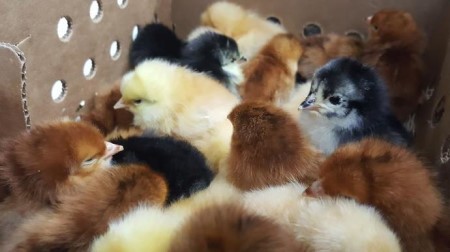Current Store
REBOY SUPPLY INC.

HEALTH OF CHICKS - The chicks are shipped to us the day after they are hatched. If you have any concerns as to their health, you must say so when picking them up. Once you take them home, we have no control over how you cared for them and can not be responsible for any losses. Any refunds will not exceed the original purchase price of the chicks.
SEXED PULLETS ACCURACY IS 90%
For more information call us at: 716-652-4321
CARE AND BROODING INSTRUCTIONS FOR POULTRY
BEFORE YOUR CHICKS ARRIVE - Set up your brooder three days in advance of your chick pickup date. Have the shavings in place and your waterer with room temperature water and electrolytes along with the feed in the brooder. Turn on the heat lamp and get the temperature adjusted to 95 degrees F. Doing this three days in advance gives you ample time to get the temperature adjusted. Now when you bring the chicks home, you won't be scrambling to get everything setup and trying to bring up the temperature up to the 95 degrees F. When you get home with your chicks you can take them one at a time out of the shipping box and dip their beak first in the water then in the feed and set them in the brooder. This gets them drinking and eating faster. Remember they are under a lot of stress from shipping and they are dehydrated and the faster you get them in the proper temperature and drinking and eating the better the survival rate will be.
CONTAINMENT AND TEMPERATURE - Start with clean quarters. Chicks need to be kept a 95 degrees F for the first 10 days. This is extremely important. Decrease the temperature by 5 degrees F each week thereafter. The ideal temperature for a 6 week old bird is 70 degrees F. the most common source of heat is a 250 watt bulb. We recommend a barrier or draft guard be placed around your brooder lamp. This contains your birds and keeps young chicks within a reasonable amount of space (.5 sqft/bird) thus keeping them closer to the heat source. When decreasing temperature consider the behavior of your chicks at all times - if they are constantly huddling they are likely too cold. If they're evenly dispersed, moving around and eating and drinking they are comfortable.
LITTER - Provide a 2 to 4 inch depth of suitable litter. Pine Shavings are ideal as they are absorbent, accessible and have enough texture for foot grip, yet too large to be eaten. Never use straw, newspaper or any other slick surface as it could cause crippling leg issues.
FOOD and WATER - Chicks must have fresh food and water at all times. Feed a quality medicated starter feed for the first 8 weeks then switch to a grower feed. Feed choice will vary by breed, purpose, etc. You can scatter a fine grit over the feed. Chicks may need direction to feed and water initially; we recommend dipping each birds beak in the water then into the feed upon un-boxing. Water should be luke-warm. Feed and water should be placed at a midpoint between the heat source and the barrier.
SUPPLEMENTS - We cannot stress enough the benefits of adding a Vitamin Stress Pack to the drinking water for the first week. The majority of chick loss within or shortly after shipping is directly related to stress and dehydration. Our Vitamin Stress Pack is specifically formulated to stimulate water consumption and combat potential shipping stress.
AFTER YOU TOUCH DUCKLINGS OR CHICKS, WASH YOUR HANDS SO YOU DON'T GET SICK!
Contact with live poultry (chicks, chickens, ducklings, ducks, geese and turkeys) can be a source of human Salmonella infections. Salmonella germs can cause a diarrhea illness in people that can be mild, severe or even life threatening. Chicks, ducklings and other live poultry can carry Salmonella germs and still appear healthy and clean. Salmonella germs are shed in their droppings and can easily contaminate their bodies and anything in areas where live birds live and roam.
SAFE HANDLING OF CHICKS & CHICKENS - Always wash your hands thoroughly with soap and warm water after handling live poultry or anything associated with your flock. Hand sanitizer can be used if soap and water are not available. Adults should supervise hand washing of children. Children younger than 5 years old, people with weak immune systems or the elderly should not handle or touch live chickens or other live fowl. Live poultry should never enter your house, especially bathrooms, kitchens or living areas where food and drink are served, stored or prepared. Live poultry should never be snuggled, kissed or cuddled.
